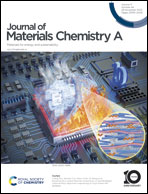Coupling PtZn intermetallic and atomically dispersed cobalt towards efficient and stable oxygen reduction reaction catalysts†
Abstract
PtZn is a promising catalyst candidate for the oxygen reduction reaction (ORR) due to its low intermetallic formation energy and high potential stability under reaction conditions. However, the fully occupied electron configuration of Zn (3d104S2) reduces its affinity for surface oxygen species, thus limiting its ORR activity. Herein, we propose a straightforward strategy to prepare small-size PtZn intermetallic nanoparticles supported on a porous carbon that contains atomically dispersed Co anchored at N–C sites (PtZn–CoNC). The coupled PtZn–CoNC catalyst delivers superior ORR activity and remarkable durability with a half-wave potential variation of just 5 mV after 30 000 cycles. The high ORR performance of PtZn–CoNC is associated with the strong metal–support interaction between the PtZn nanoparticles and atomically dispersed Co sites (Co–Nx), as well as the confinement effect of the porous carbon substrate. Density functional theory calculations reveal that Co–Nx sites can adjust the electronic structure of Pt to further optimize the binding energies of oxygen-containing intermediates, thus enhancing ORR activity.



 Please wait while we load your content...
Please wait while we load your content...